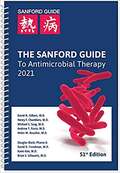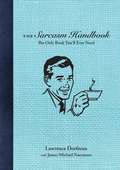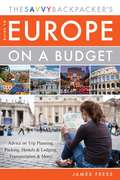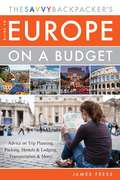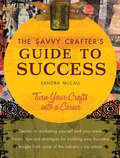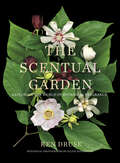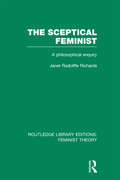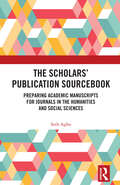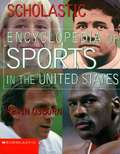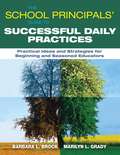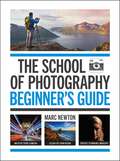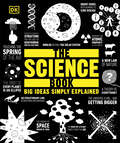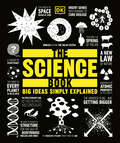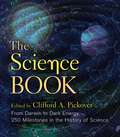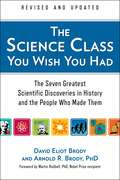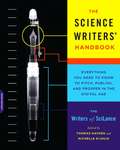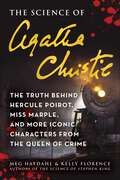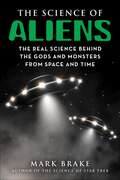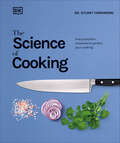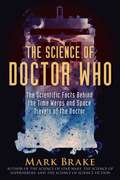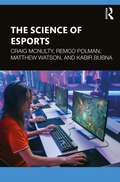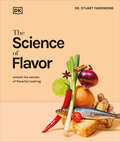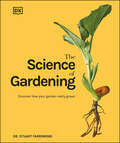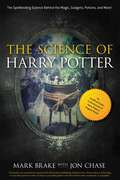- Table View
- List View
The Sanford Guide to Antimicrobial Therapy 2021
by David N. Gilbert M. D. Michael S. Saag Henry F. Chambers Andrew T. Pavia Helen W. BoucherThe 51st edition of the leading clinical reference on treatment of infectious diseases and anti-infective drug information. Helpful in day-to-day practice and as a component of your organization's antimicrobial stewardship program, The Sanford Guide provides valuable guidance in the age of antibiotic resistance. <p><p>Popular with physicians, pharmacists, physician assistants, nurse practitioners, and other clinicians, The Sanford Guide to Antimicrobial Therapy provides information that is convenient, concise, and reliable. <p><p>Coverage includes: Clinical syndromes, pathogens (bacterial, fungal, mycobacterial, parasitic, viral), anti-infective agents, dosing with pediatric and renal adjustments, adverse affects, spectra of activity, pharmacology, drug-drug interactions, and preventative therapy.
The Sarcasm Handbook
by Lawrence Dorfman James Michael NaccaratoFrom the author of the bestselling Snark series comes the premiere guide to satire, sneering, jeering, and mockery in their finest forms. A surviving knight of many a verbal joust, Larry Dorfman has become an expert at backhanded sass and cathartic banter.Featuring life lessons from the master himself, as well as quotes and quips by some of history’s sarcastic greats, The Sarcasm Handbook teaches readers how to deflect stupidity and express their inner dissatisfaction with a keen sensibility, hushing subtlety, and wisecrack wit. Included in these invaluable teachings are chapters on achieving the right tone, sarcastic bastards in history, as well as scenarios depicting some of the greatest moments in sarcasm.So pick up your copy today and start learning the art of disparagement through passive aggressiveness!
The Savvy Backpacker's Guide to Europe on a Budget: Advice on Trip Planning, Packing, Hostels & Lodging, Transportation & More!
by James FeessA comprehensive guide to backpacking through Europe.
The Savvy Backpackers Guide to Europe on a Budget
by James FeessA comprehensive guide to backpacking through Europe.
The Savvy Crafter's Guide to Success: Turn Your Crafts Into A Career
by Sandra MccallTake your crafts out of your workshop - and into the spotlight. Do you dream of making money with your art but feel unsure of how to begin? With The Savvy Crafter's Guide to Success, turning your hobby into a career is easier than you think. Leave the boring business books to the white-collar set! In these pages filled with plenty of artwork for inspiration, renowned rubber-stamp and polymer-clay artist Sandra McCall teaches you everything you need to know about successfully marketing and selling your work. She shares personal insights from some of the industry's top crafters, including Traci Bautista, Claudine Hellmuth, Michael Jacobs, Catherine Moore and Stephanie Olin. With sound advice, valuable do's and don'ts, and plenty of encouragement, you'll learn to: Become a regular contributor to craft publications Start teaching workshops at stores, retreats and craft shows Assert yourself as an "expert" in your field Turn your dreams into reality. Turn your crafts into a career!
The Scentual Garden: Exploring the World of Botanical Fragrance
by Ken DruseA complete illustrated survey of fragrant flowers and plants, from a celebrated gardening expert and an award–winning botanical photographer. Popular garden writer Ken Druse offers a complete survey of fragrance in the garden, in a major work filled with new knowledge. He arranges both familiar and unusual garden plants, shrubs, and trees into twelve categories, giving gardeners a vastly expanded palate of scents to explore and enjoy, and he also provides examples of garden designs that offer harmonious scentual delights. Ellen Hoverkamp contributes her artful botanical images of flowers and plants discussed in the text. These are accompanied by Druse’s award-winning garden photographs, to create a book that is as beautiful to look at as it is informative and evocative to read.
The Sceptical Feminist: A Philosophical Enquiry (Routledge Library Editions: Feminist Theory)
by Janet Radcliffe RichardsA systematic and original study of feminist issues, The Sceptical Feminist fights a battle on two fronts: against the view that little or nothing is wrong with women’s position, and at the same time against much current feminist dogma. It is written by a philosopher who, in the tradition of John Stuart Mill’s classic The Subjection of Women, avoids the psychological and sociological speculation characteristic of much recent feminism and concentrates on the analysis of arguments. By these means she constructs a powerful and often unexpected case for radical change in the position of women, as well as for a change of attitude among many feminists. From her analysis, Janet Radcliffe Richards argues that positive discrimination in favour of women is essential for justice, that traditional sexual roles never had anything to do with beliefs about each sex’s capabilities, that current abortion practice reflects a disguised wish to punish women’s sexual activity, that ‘women’s work’ is rightly little valued, and that traditional ideals of femininity are inherently pernicious. But she also argues that a movement for sexual justice cannot ‘take the woman’s side in everything’, that feminism should not be thought of as the primary struggle, that dismissing ‘male’ logic and science will undermine feminists’ own intentions, that the state should not subsidise motherhood, that ever available crèches would be disastrous for women, that there is no inherent degradation in prostitution, and that contempt for beauty and adornment has nothing to do with feminism. This is a book for feminists, for their critics, and for students of moral, political and social philosophy.
The Scholars’ Publication Sourcebook: Preparing Academic Manuscripts for Journals in the Humanities and Social Sciences
by Seth AgboThis book is a comprehensive guide for instructors and graduate students on preparing scholarly manuscripts for peer-reviewed journals, theses, or dissertations in the humanities and social sciences.Providing a toolbox of approaches to understand the structures around manuscript preparation, it offers an in-depth understanding of the different types of manuscripts and the nuanced approaches required. It illuminates each stage of the process, from the initial identification of a topic to the publication of the final article. It draws on the expertise of various contributors, including journal editors, editorial board members, peer reviewers, and research methods instructors. The book is a practical guide for all instructors and students seeking insight into the publishing process in high-impact journals. It draws from case studies across various fields such as sociology, psychology, political science, business studies, policy research, and public health.The book will be of particular relevance to early-career scholars, graduate students, and instructors working with students preparing theses, dissertations, or journal articles. It serves as a valuable resource for understanding and navigating the complex world of academic publishing.
The Scholastic Encyclopedia of Sports in the United States
by Kevin OsbornThis volume explores the fascinating history of American sports, from being the Devil's pastime in Puritan New England to the celebrity-filled big business it is today. Readers will learn about many stars as well as less famous athletes, and the personal attributes of players that make them outstanding and influential people.
The School Principals' Guide to Successful Daily Practices: Practical Ideas and Strategies for Beginning and Seasoned Educators
by Marilyn L. Grady Barbara L. BrockWhile many books outline the attributes of successful school leaders, few describe how those traits manifest in daily practice. The Daily Practices of Successful Principals goes beyond the outward picture of excellence and provides a compendium of daily practices used by successful principals in various settings. Written by former administrators who have walked in your shoes, this handy guide's strategies are based on interviews with successful leaders and are applicable in multiple contexts. Inside you will find guidelines for: Examining your values, educational platform, and personal style Establishing learning as a common purpose Identifying and leading school change Managing staff and student relationships effectively Developing teacher leadersThe authors understand that principals are expected to have the patience of Job, the tenacity of Atlas, the compassion of Mother Teresa, and a sense of humor. The recommended daily practices will help you stay focused on the most important things-leading effectively, promoting student achievement, and making a positive difference in students' lives.
The School of Photography: Beginner's Guide
by Marc NewtonThe School of Photography: Beginner's Guide will take the beginner photographer to an advanced level in no time and fill any gaps in photography knowledge that may be holding you back from reaching your full potential. You'll be able to use your camera confidently in all the manual modes and apply the knowledge gained to any situation. The book will make you feel completely confident and ensure your shots stack up against any professional-looking photography.It's for people who want to take photography more seriously and will suit beginners, keen enthusiasts or anyone looking to make photography their profession. This book will put an end to any confusion, while giving you accurate and thorough knowledge in photography.Topics covered include:- Camera kits and equipment- Working in manual settings- Composition- Apertures and depth of field- Shutter speeds- Night photography
The School of Photography: Beginner's Guide
by Marc NewtonThe School of Photography: Beginner's Guide will take the beginner photographer to an advanced level in no time and fill any gaps in photography knowledge that may be holding you back from reaching your full potential. You'll be able to use your camera confidently in all the manual modes and apply the knowledge gained to any situation. The book will make you feel completely confident and ensure your shots stack up against any professional-looking photography.It's for people who want to take photography more seriously and will suit beginners, keen enthusiasts or anyone looking to make photography their profession. This book will put an end to any confusion, while giving you accurate and thorough knowledge in photography.Topics covered include:- Camera kits and equipment- Working in manual settings- Composition- Apertures and depth of field- Shutter speeds- Night photography
The Science Book (DK Big Ideas)
by DKLearn about our world, the universe, and groundbreaking discoveries in The Science Book.Part of the fascinating Big Ideas series, this book tackles tricky topics and themes in a simple and easy to follow format. Learn about Science in this overview guide to the subject, great for beginners looking to learn and experts wishing to refresh their knowledge alike! The Science Book brings a fresh and vibrant take on the topic through eye-catching graphics and diagrams to immerse yourself in. This captivating book will broaden your understanding of Science, with:- More than 100 ground-breaking ideas in this field of science- Packed with facts, charts, timelines and graphs to help explain core concepts- A visual approach to big subjects with striking illustrations and graphics throughout- Easy to follow text makes topics accessible for people at any level of understandingThe Science Book is the perfect introduction to every area of this topic – astronomy,biology, chemistry, geology, maths, and physics, aimed at adults with an interest in the subject and students wanting to gain more of an overview. Here you’ll discover 80 trail-blazing scientific ideas, which underpin our modern world, giving us everything from antibiotics to gene therapy, electricity to space rockets, and batteries to smart phones.Your Science Questions, Simply ExplainedWhat is string theory or black holes? And who discovered gravity and radiation? If you thought it was difficult to learn structure and behavior of the physical and natural world, The Science Book presents key information in a clear layout. Learn about the history of science, covering topics like why Copernicus’s ideas were controversial, how Einstein developed his theories of general and special relativity, and how Crick and Watson suggested a structure for DNA - with fantastic mind maps and step-by-step summaries.The Big Ideas SeriesWith millions of copies sold worldwide, The Science Book is part of the award-winning Big Ideas series from DK. The series uses striking graphics along with engaging writing, making big topics easy to understand.
The Science Book: Big Ideas Simply Explained (DK Big Ideas)
by DKNow in Paperback! Take science to a whole new level. Created in partnership with Prentice Hall, the Big Idea Science Book is a comprehensive guide to key topics in science falling into four major strands (Living Things, Earth Science, Chemistry, and Physics), with a unique difference — a website component with 200 specially created digital assets that provide the opportunity for hands-on, interactive learning.
The Science Book: From Darwin to Dark Energy, 250 Milestones in the History of Science (Union Square & Co. Milestones)
by Clifford A. PickoverFrom astronomy to psychology, this beautifully illustrated chronology presents the most important and groundbreaking milestones in science. Award-winning author Cliff Pickover (The Math Book, The Physics Book, and The Medical Book) gathers into one fully illustrated volume the most important thinkers and ideas in the history of science. This unique omnibus edition includes 250 thoughtfully selected entries from many of the science-based books in the Sterling Milestones series, including math, physics, medicine, biology, chemistry, engineering, psychology, and space. With a new introduction by Pickover explaining how this impressive collection was curated,The Science Book showcases humanity&’s greatest achievements and provides readers with a sense of wonder at the diversity of scientific discovery.
The Science Class You Wish You Had (Revised Edition)
by A. Brody D. BrodyWhat does E=mc2 really mean? What is DNA? What was the big bang? These scientific concepts have changed our perception of the world...but for many of us they remain mysteries, bits and pieces of information retained from classroom lectures but never truly understood. Now we can finally grasp the grandeur and complexity of these ideas, and their significance in our lives. Revised and updated to include the latest discoveries that are changing the way we view the world and the universe, this new edition of The Science Class You Wish You Had will take you on a journey through space and time--from the subatomic to the universal. It explains in a lively, accessible way what these milestones of scientific discovery mean and what direct impact they have on our lives today and will have in the future. For everyone interested in science, history, and biographies of extraordinary people--or anyone who wants to understand the workings of the physical world--this thorough and authoritative book is a perfect introduction to science's most profound discoveries, and a testament to the triumph of human knowledge. Newton: Gravity and the Basic Laws of Physics Rutherford and Bohr: The Structure of the Atom Einstein: The Principle of Relativity Hubble: The Big Bang and the Formation of the Universe Darwin: Evolution and the Principle of Natural Selection Flemming and Mendel: The Cell and Genetics Watson and Crick: The Structure of the DNA Molecule
The Science Writers' Handbook: Everything You Need to Know to Pitch, Publish, and Prosper in the Digital Age
by Thomas Hayden Michelle NijhuisPopular science writing has exploded in the past decade, both in print and online. Who better to guide writers striving to succeed in the profession than a group of award-winning independent journalists with a combined total of 225 years of experience? <P><P>From Thomas Hayden’s chapter on the perfect pitch to Emma Maris’s advice on book proposals to Mark Schrope’s essential information on contracts, the members of SciLance give writers of all experience levels the practical information they need to succeed, as either a staffer or a freelancer. Going beyond craft, The Science Writer’s Handbook also tackles issues such as creating productive office space, balancing work and family, and finding lasting career satisfaction. It is the ultimate guide for anyone looking to prosper as a science writer in the new era of publishing.
The Science of Agatha Christie: The Truth Behind Hercule Poirot, Miss Marple, and More Iconic Characters from the Queen of Crime (The Science of)
by Meg Hafdahl Kelly FlorenceUncover the theories behind Dame Agatha Christie's most thrilling mysteries: Murder on the Orient Express, Death on the Nile, The A.B.C. Murders, and so much more! Gothic media moguls Meg Hafdahl and Kelly Florence, authors of The Science of Stephen King and co-hosts of the Horror Rewind podcast called &“the best horror film podcast out there&” by Film Daddy, present a guide to the Agatha Christie stories and supersleuths we all know and love. Through interviews, literary and film analysis, and bone-chilling discoveries, The Science of Agatha Christie uncovers the science behind the sixty-six detective novels and fourteen short story collections that have become an integral part of the modern murder mystery, answering such questions as: What is the science behind the poisons used to commit murders in Agatha Christie&’s stories? When did crime investigation become more common as seen in Murder on the Orient Express? Has science made it possible to uncover the truth behind the investigative powers of Hercule Poirot and Miss Marple? How did Agatha Christie use isolated settings to best explore the psychology of her characters? Join Kelly and Meg as they discover why sometimes the impossible must be possible!
The Science of Aliens: The Real Science Behind the Gods and Monsters from Space and Time (The Science of)
by Mark BrakeDiscover the real science behind 2001, ET, Signs, and all your favorite fictional alien civilizations.As space telescopes continue to search for life in this unearthly Universe, the crucial questions remain unanswered. Are we awake to the revolutionary effects on human society and science that alien contact will bring? And how is it possible to imagine the unknown? The Science of Aliens tells the compelling story of how the portrayal of alien life has evolved over time.Taking examples from science, film, and fiction, this book showcases how scholars, filmmakers, and authors have devoted their energies to imagining life beyond this Earth. From Copernicus to Kubrick, The Science of Aliens is a fascinating account for anyone interested in extraterrestrials.Otherworldly topics include:What Xenomorphs from Alien and Na&’vi from Avatar have in commonDarwin among aliensExtraterrestrials in Einstein&’s skyAliens in our space ageAnd so much moreVisualize the unknown and redefine your place in a changing cosmos with The Science of Aliens.
The Science of Cooking: Every Question Answered to Perfect Your Cooking
by Dr. Stuart FarrimondEvery question you&’ve ever had about everyday cooking and the science behind it — answered.How do I cook the perfect steak? How does citrus juice cook raw fish? Why does garlic make your breath smell? This fascinating science-based cookbook sheds light on questions that have puzzled generations of cooks!Discover a recipe book like no other from TV personality, food scientist and bestselling author Dr. Stuart Farrimond. Inside, you&’ll discover: • Dynamic, full-color visuals make complex scientific concepts compelling and easy to understand. • Engaging question-and-answer format makes the science relevant to everyday cooking. • User-friendly book structure, with scientific concepts organized by food group and ingredient. • Step-by-step techniques — which demonstrate and underpin key concepts — add core, practical cooking instruction. Discover the techniques behind cookingA good recipe goes a long way, but if you can master the science behind it, you&’ll be one step ahead. The Science of Cooking shows you how by bringing food science out of the lab and into your kitchen. It gives you all the scientific information you need to take your home cooking to a whole new, more nutritious level! From making great risotto and soft ice cream to the process of steaming, this gastronomic cookbook includes step-by-step techniques to help you perfect your cooking. 3D graphics and engaging text make scientific concepts easy to grasp, and infographics bring culinary facts and stats to life. It is the ultimate gift for any self-respecting foodie or cook!Hungry for more?Don&’t stop with The Science of Cooking - there are more books to discover! This series from DK is designed to help you perfect your cooking with practical instruction and understand what&’s going on behind the scenes as you cook! Explore the science behind the art of making incredible spice blends to help you release the flavor in your dishes with The Science of Spice.
The Science of Doctor Who: The Scientific Facts Behind the Time Warps and Space Travels of the Doctor (The Science of)
by Mark BrakeGeek out over the TARDIS, aliens, alternate timelines, parallel worlds, and all your favorite characters from the Doctor Who Universe!Doctor Who arrived with the Space Age, when the Doctor first began exploring the universe in a time-traveling spaceship. Over half a century since, the Doctor has gone global. Millions of people across this planet enjoy Doctor Who in worldwide simulcast and cinema extravaganzas. Doctor Who has infused our minds and our language and made it much richer.What a fantastic world we inhabit through the Doctor. The program boils over withballsy women, bisexual companions, scientific passion, and a billion weird and wonderful alien worlds beyond our own. The show represents almost sixty years' worth of magical science-fiction storytelling. And Doctor Who is, despite being about a thousands-of-years-old alien with two hearts and a spacetime taxi made of wood, still one of our very best role models of what it is to be human in the twenty-first century.In The Science of Doctor Who, we take a peek under the hood of the TARDIS and explore the science behind questions such as:What does Doctor Who tell us about space travel? Could the TARDIS really be bigger on the inside?In what ways does the Doctor view the end of our world? Is the Doctor right about alternate timelines and parallel worlds?Will intelligent machines ever rule the earth?Is the earth becoming more like Doctor Who's matrix?Is the Doctor a superhero? How do daleks defecate?So welcome to The Science of Doctor Who, where the Doctor steps smoothly in and out of different realities, faces earthly and unearthly threats with innovation and unpredictability, and successfully uses science in the pay of pacifist resistance!
The Science of Esports
by Matthew Watson Craig McNulty Remco Polman Kabir BubnaThe Science of Esports draws from contemporary research and coach expertise to examine esports athlete health and performance from a range of disciplinary perspectives, including physiology, psychology, sociology, and nutrition. The rapid expansion of the esports industry has elevated competitive video gaming into the realm of high performance, requiring players, coaches, and practitioners to implement interdisciplinary approaches to performance support. The book covers key topic areas such as: What esports is and similarities and differences to sport Game-specific training Physiological and psychological consideration for esports athletes Social aspects of player performance and the social environment of esports Esports coaching and structure of esports performance environments Technology and its use in esports Safeguarding, cheating, and gambling This book includes worked examples and case studies to allow immediate implementation into practice for esports athletes and coaches. It summarises the current state of research to inform researchers and identify gaps in knowledge. This book is critical reading for students of esports and related courses. It serves as the first scientific resource designed to provide athletes, coaches, and practitioners with interdisciplinary insights into esports health and performance.
The Science of Flavor: Unlock the Secrets of Flavorful Cooking
by Dr. Stuart FarrimondThey say you eat with the eyes. But we now know that smell, texture, temperature, color and even atmosphere – down to the background music – influence how we perceive flavor. As anyone who has lost their sense of taste will know, flavorless food is dull and monochrome - it is flavor that brings food into full technicolor life. Yet it's not always easy to make something tasty; the secrets to flavor can baffle chefs and scientists alike. Food science expert Dr Stuart Farrimond explores major flavor categories such as salt, acid and heat (from chilies) and how they interact, and profiles all the major foods from individual fruit, veg, herbs and spices to the building blocks such as rice and wheat that give us stapes like bread, pasta, and noodles. With pairing notes for every ingredient, you'll soon be inventing new recipes.
The Science of Gardening: Discover How Your Garden Really Works
by Dr. Stuart FarrimondExploding myths and providing key takeaway advice for gardeners at any level, this book provides a shortcut to decades of gardening experience by explaining the science behind how a garden grows.How often should I water my plants? What&’s the most effective slug deterrent? Could I breed my own unique variety of flower? Do plants have intelligence? Does it really matter when and how I prune? And why is my compost heap so slimy? If you find yourself seeking the answers to these questions and many more, then this may be the book for you!The world of gardening can be a mystifying place, with so many instructions to follow and often little explanation as to why. Dr Stuart Farrimond casts his scientific eye over the garden to answer all the horticultural questions you&’ve ever wondered about.Get your gardening gloves on and dive straight in to discover:- An accessible guide structured around the life cycle of the garden, taking you from first shoots to pruning for renewal.- An accessible Q &A format, with stats and infographics to bring the story to life, as well as long-held gardening myths are exploded by new science.- Every way to greener fingers has action points so that you can understand the science, apply your gardening practice, and enjoy a flourishing garden.From hands-on, practical advice, to an exploration of the mental health benefits of gardening, whilst also covering topics such as the positive impact gardening can have on the earth during a time of climate crisis, The Science of Gardening debunks myths, and reveals the latest science often only taught at horticultural college. As a passionate newcomer to gardening, daunted by the mountain of often conflicting advice in gardening manuals, Dr Stuart Farrimond has set about testing the scientific basis of so much conventional wisdom and practice so you too can garden like a pro.A must-have gardening book for keen beginners with a passion for plants but who are daunted by the prospect of trawling through traditional gardening manuals for explanations, as well as experienced gardeners who are intrigued to find out the theory behind their practice and who want to improve on where they might be getting something wrong.At DK, we believe in the power of discovery. So why stop there? If you like Science of Gardening, then why try Science of Cooking or Science of Spice to complete the collection.
The Science of Harry Potter: The Spellbinding Science Behind the Magic, Gadgets, Potions, and More! (The Science of Series)
by Mark Brake Jon ChaseHow does magic in J. K. Rowling’s universe work? Finally, the scientific secrets are revealed!The story of the boy who lived has brought the idea of magic and sorcery into mainstream fruition more than any other book series in history. Modern muggle scientists have uncovered explanations to the seemingly impossible, including answers to such questions as: Will we ever see an invisibility cloak? How hazardous is a flying broomstick like the Nimbus 2000? How has medicine made powerful potions from peculiar plants? (Felix Felicis, anyone?) Can scientists ever demonstrate Wingardium Leviosa, or the flying power of a Golden Snitch? Is it possible to stupefy someone? And many more!Often perceived as a supernatural force, magic captivates and delights its audience because of its seeming ability to defy physics and logic. But did you ever wonder if science has any explanation for these fantastic feats? The Science of Harry Potter examines the scientific principles—behind some of your favorite characters, spells, items, scenes, and even games like Quidditch and Wizard’s Chess—from boy wizard Harry Potter’s world, providing in-depth analysis and scientific facts to support its theories. Author Mark Brake, whose The Science of Star Wars was a knockout success, has found the answers to satisfy the curious spirits of muggles everywhere…A perfect Harry Potter gift for anyone obsessed enough to stand in line to be the first to see Harry Potter and the Cursed Child or Fantastic Beasts and Where to Find Them, witches and wizards alike will be fascinated by the merging of this improbable realm and real science!
